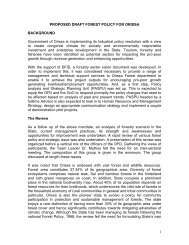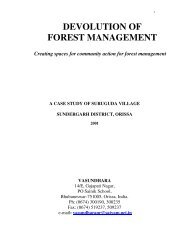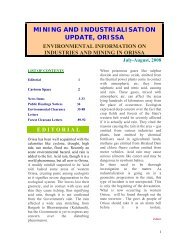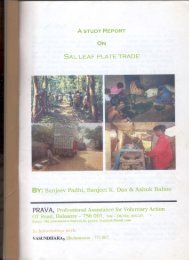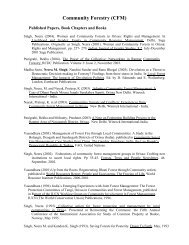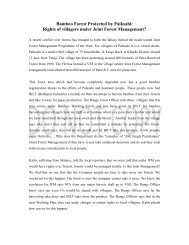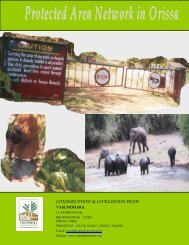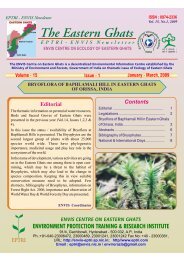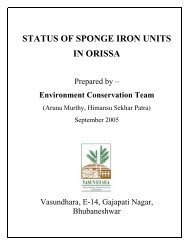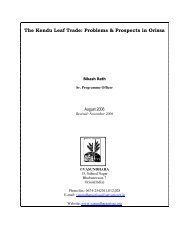Bamboo in Orissa: Trade and Livelihood Perspective - Vasundhara
Bamboo in Orissa: Trade and Livelihood Perspective - Vasundhara
Bamboo in Orissa: Trade and Livelihood Perspective - Vasundhara
You also want an ePaper? Increase the reach of your titles
YUMPU automatically turns print PDFs into web optimized ePapers that Google loves.
All rights reserved by VASUNDHARA(www.vasundharaorissa.org). For any clarification, contact author at sunlit1968@yahoo.co.<strong>in</strong><br />
farm<strong>in</strong>g. These bamboo-materials are durable for two years after which they are used as<br />
fuel. And all k<strong>in</strong>ds of bamboo can be used for this purpose except<strong>in</strong>g thorny bamboo.<br />
Expenditure on bamboo varies to some extent accord<strong>in</strong>g to the farm<strong>in</strong>g practices. For<br />
<strong>in</strong>stance, <strong>in</strong> Nimapara <strong>and</strong> Puri districts the betel farms are situated at a higher level i.e.,<br />
about 3 to 4 feet above the ground; <strong>and</strong> the bamboo used is of comparatively greater height<br />
than that <strong>in</strong> the Jagats<strong>in</strong>ghpur district where farms are on the ground level. Similarly, <strong>in</strong><br />
Nimapara district bamboo is almost the only raw material used for roof<strong>in</strong>g whereas <strong>in</strong><br />
Jagats<strong>in</strong>ghpur district branches of Casuar<strong>in</strong>a etc. are sufficiently used for the same purpose.<br />
Purchase prices also differ.<br />
Pakhudi is as thick as the f<strong>in</strong>ger. Farmers br<strong>in</strong>g the bamboo culms <strong>and</strong> employ labourers to<br />
make pakhudis out of that 34 . On contract basis, a labourer may charge Rs.12 to 15 for<br />
mak<strong>in</strong>g a pana(80 pieces) of pakhudis (6.5 to 7 feet high) <strong>in</strong> parts of Jagats<strong>in</strong>ghpur district.<br />
The time taken may be about 1.5 to 2 hours.<br />
For fenc<strong>in</strong>g <strong>and</strong> roof<strong>in</strong>g purpose, split-bamboo is used <strong>in</strong> the form of b<strong>in</strong>chana <strong>and</strong> phalia.<br />
B<strong>in</strong>chana is approx. 9 feet high <strong>and</strong> thick like a f<strong>in</strong>ger. For mak<strong>in</strong>g 80 pieces of b<strong>in</strong>chana, a<br />
labourer may take about 3 hours <strong>and</strong> gets Rs.20. Phalia is about 7 ft high <strong>and</strong> 3 <strong>in</strong>ches<br />
wide, <strong>and</strong> for mak<strong>in</strong>g 20 such pieces a labourer may take 30 m<strong>in</strong>utes <strong>and</strong> gets Rs.7 <strong>in</strong> the<br />
Nimapara region.<br />
In Jagats<strong>in</strong>ghpur district, the phalia-like pieces are known as bata <strong>and</strong> the pakhudimakers(labourers)<br />
are usually asked to split bata <strong>in</strong>to pakhudi. For mak<strong>in</strong>g 80 pakhudis, it<br />
may take them 45 m<strong>in</strong>utes on an average for which they get Rs.10 plus food.<br />
Before the super-cyclone of 1999 the betel-farmers used to ensure some supply of bamboo<br />
from the local sources at low prices. Besides, bamboo used to come from Ganjam <strong>and</strong><br />
other districts where bamboo-cutt<strong>in</strong>g operations were carried out by the Forest Department.<br />
After 1999, while most of the local clumps vanished under the cyclonic effect, ban on<br />
bamboo-cutt<strong>in</strong>g operations severely affected supply from other districts. Acute shortage<br />
<strong>in</strong>creased the rates by about 10 times, <strong>and</strong> the betel-farmers found it extremely difficult to<br />
susta<strong>in</strong> their farms. Thus, farm<strong>in</strong>g was reduced by about 50%. In the recent past, th<strong>in</strong>gs<br />
have started improv<strong>in</strong>g <strong>and</strong> betel farm<strong>in</strong>g is gradually reviv<strong>in</strong>g itself. Most of the raw<br />
material (bamboo) now comes from north <strong>Orissa</strong> <strong>in</strong> every two weeks <strong>and</strong> s<strong>in</strong>ce the farmers<br />
are critically dependent on betel cultivation, they try to cont<strong>in</strong>ue their age-old profession<br />
somehow.<br />
Betel bus<strong>in</strong>ess is badly dependent on three types bamboo baskets specially made for this<br />
purpose. The varieties are as under:<br />
• Pata: Big size baskets used for local transportation of betel. A family can make 10<br />
such baskets <strong>in</strong> a day.<br />
34 Some just purchase pakhudis directly.<br />
68



